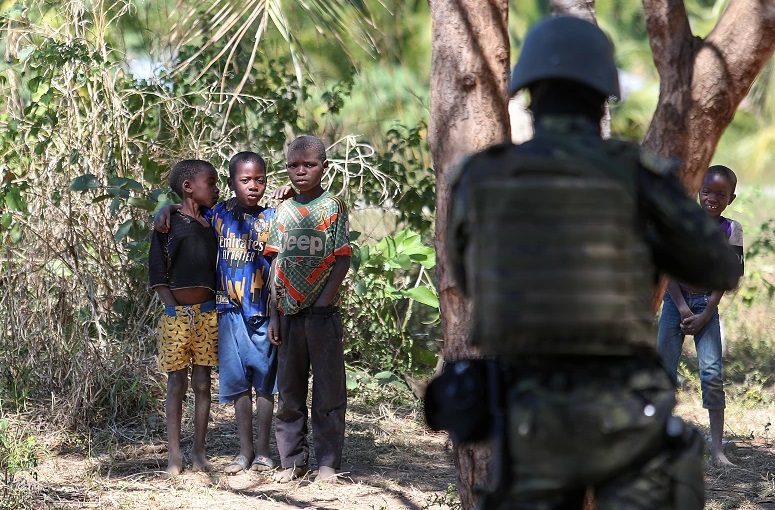Mozambique: Xai-Xai water supply disrupted
Mozambique: Insurgent killings down 71% in 2023 thanks to SADC, Rwanda – report

File photo: Lusa
Violence perpetrated by Islamic extremists in northern Mozambique fell by 71% in 2023, the Africa Center for Strategic Studies (ACSS) said on Wednesday, attributing the drop to the offensive launched by SADC and Rwandan forces.
The total number of violent incidents recorded by the US analysis institute in northern Mozambique was 127, with 260 deaths resulting from them. Nevertheless, “850,000 internally displaced people have still not returned home,” writes the ACSS.
“This is attributable to last year’s offensive by SADC and Rwandan forces, deployed in July 2021 to help the Mozambican army dislodge extremists from the towns of Palma and Mocimboa da Praia,” according to the Washington-based institute.
Those forces “managed to regain control of 90% of the territory” controlled by the Ahlu Sunnah wa Jama’a (ASWJ, a group known as al Shabaab) insurgents, “expelling the survivors to the rural areas of the Macomia district, where they now operate in small groups without bases, carrying out random attacks against civilians,” adds the ACSS infographic.
Last year, there was an 80% reduction in violence against civilians, a figure considered “particularly remarkable” by the institute, given that the violence of Islamic militants in northern Mozambique has always been characterised by high levels of violence against civilians.
Last year, 23% of deaths in northern Mozambique were attributed to violence against civilians, with 53 attacks against civilians and 61 deaths, a record that compares with 286 attacks and 438 deaths in 2022.
“The question for this year will, therefore, be whether this progress can be maintained, given the resilience of the militants in this region,” concludes the ACSS, considering it “important to address the grievances that are the root causes of instability in Cabo Delgado”.
In contrast to the record in Mozambique, the number of deaths as a result of violence by Islamic extremist groups on the continent continues to rise – up by 20% in 2023, to a total of 23,322 (compared to 19,412 in 2022) – with more than 80% of the deaths occurring in the Sahel and Somalia. The number of deaths in 2023 doubles that recorded in 2021.
Deaths linked to violence by Islamist militants increased by 20% this year, from 19,412 in 2022 to a new record of 23,322 last year, a figure that represents a doubling of the number of deaths in 2021.
The Sahel (11,643 deaths, 43% more than in 2022) and Somalia (7,643, 23% more) were the most violent stages of killings by Islamic extremists across the continent, responsible for 83% of the deaths recorded in 2023.
Deaths in the Sahel account for 50% of the deaths recorded in Africa attributable to Islamic militants in 2023. By way of comparison, deaths in the Sahel attributable to Islamist militants in 2020 accounted for 30% of the deaths recorded in Africa at that time, the ACSS points out, safeguarding that the figures could be even higher.
The US institute emphasises that the “dramatic reduction in media space” in the region has prevented publicising the growing insecurity in Mali, Burkina Faso and Niger since the coups d’état in these countries between 2020 and 2023, justified by the respective military juntas precisely because of the failure of their elected governments to combat violent Islamic extremism.
Most of the increase in deaths in the region is attributable to the Jama’at Nusrat al Islam wal Muslimin (JNIM) coalition, which includes the Front de libération du Macina and the Ansaroul Islam group. This coalition is associated with a 67% increase in the number of deaths recorded to a total of 9,195, compared to 5,499 in 2022.
The JNIM coalition is associated with 81% of the violence by Islamic extremists in the Sahel.
In contrast, deaths associated with the Islamic State in the Greater Sahara (EIGS) decreased by 7% in 2023, to a total of 2,448 recorded deaths.
In Somalia, the second most vulnerable to violence from Islamic extremism across the continent, violent events were all attributable to al Shabaab, with the majority (65%) related to fighting between Somali government troops and the Islamist movement’s forces.
The conflict, combined with drought and flooding, has contributed to 4.3 million people being exposed to food insecurity.












Leave a Reply
Be the First to Comment!
You must be logged in to post a comment.
You must be logged in to post a comment.